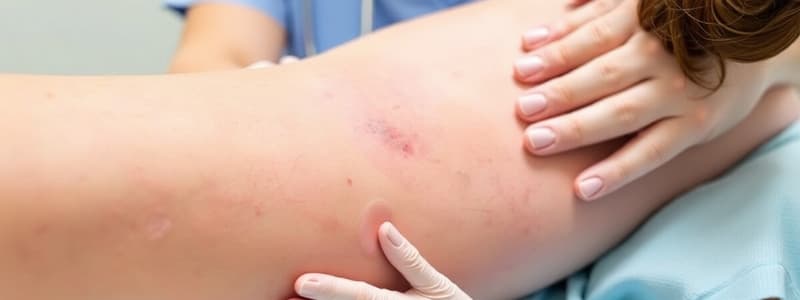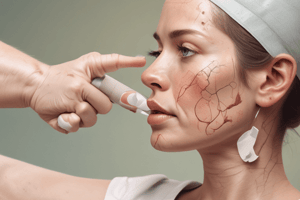Podcast
Questions and Answers
What is NOT a common sign of dehydration?
What is NOT a common sign of dehydration?
- Rapid heart rate
- Decreased urine output
- Dry mouth and throat
- Increased appetite (correct)
Wound dressings can aid in debridement of wounds.
Wound dressings can aid in debridement of wounds.
True (A)
Name one action nurses take to promote skin integrity.
Name one action nurses take to promote skin integrity.
Perform thorough skin assessments.
A dressing provides a barrier to protect wounds from further __________.
A dressing provides a barrier to protect wounds from further __________.
Match the symptoms of dehydration with their descriptions:
Match the symptoms of dehydration with their descriptions:
Which of the following is a purpose of dressings?
Which of the following is a purpose of dressings?
When assessing for dehydration, low blood pressure is not a vital sign to monitor.
When assessing for dehydration, low blood pressure is not a vital sign to monitor.
What is one preventative measure nurses can implement to maintain skin integrity?
What is one preventative measure nurses can implement to maintain skin integrity?
What is the main site for nutrient absorption in the digestive system?
What is the main site for nutrient absorption in the digestive system?
The large intestine's primary function is nutrient absorption.
The large intestine's primary function is nutrient absorption.
What vitamin is primarily found in animal products and important for red blood cell formation?
What vitamin is primarily found in animal products and important for red blood cell formation?
The small intestine's finger-like projections that increase surface area for nutrient absorption are called __________.
The small intestine's finger-like projections that increase surface area for nutrient absorption are called __________.
Match the following vitamins with their best sources:
Match the following vitamins with their best sources:
Which vitamin deficiency is associated with anemia and poor muscle coordination?
Which vitamin deficiency is associated with anemia and poor muscle coordination?
Bacteria in the large intestine have no role in vitamin production.
Bacteria in the large intestine have no role in vitamin production.
What is the function of Vitamin C in the body?
What is the function of Vitamin C in the body?
The process of eliminating indigestible substances from the body is known as __________.
The process of eliminating indigestible substances from the body is known as __________.
Match the vitamins with their functions:
Match the vitamins with their functions:
What is a potential cause of bruits heard over the aorta?
What is a potential cause of bruits heard over the aorta?
Dullness during percussion only indicates fluid accumulation in the abdomen.
Dullness during percussion only indicates fluid accumulation in the abdomen.
What sound is typically heard over areas filled with gas during percussion?
What sound is typically heard over areas filled with gas during percussion?
In assessing the abdomen, ___________ tenderness may indicate peritoneal irritation.
In assessing the abdomen, ___________ tenderness may indicate peritoneal irritation.
Match the following types of bowel sounds with their descriptions:
Match the following types of bowel sounds with their descriptions:
What is the first step in the preparation of insulin?
What is the first step in the preparation of insulin?
In severe cases of hyperglycemia, diabetic ketoacidosis can occur.
In severe cases of hyperglycemia, diabetic ketoacidosis can occur.
What should be done if blood glucose remains low after 15 minutes of intervention?
What should be done if blood glucose remains low after 15 minutes of intervention?
To prevent aspiration risk during enteral feeding, the head of the bed should be elevated at least _____ degrees.
To prevent aspiration risk during enteral feeding, the head of the bed should be elevated at least _____ degrees.
Match the intervention with the correct condition:
Match the intervention with the correct condition:
Which symptom is NOT associated with hyperglycemia?
Which symptom is NOT associated with hyperglycemia?
It is acceptable to shake the insulin vial vigorously before drawing the dose.
It is acceptable to shake the insulin vial vigorously before drawing the dose.
What should be done before injecting insulin?
What should be done before injecting insulin?
When administering medication to promote gastric emptying, the medication metoclopramide is typically used for _____.
When administering medication to promote gastric emptying, the medication metoclopramide is typically used for _____.
How often should gastric residual volumes be measured during continuous feedings?
How often should gastric residual volumes be measured during continuous feedings?
Which of the following foods should be avoided before a stool test?
Which of the following foods should be avoided before a stool test?
Blood in stool is indicated by a chemical indicator turning red.
Blood in stool is indicated by a chemical indicator turning red.
What is an essential mineral that supports the immune system and is found in high concentrations in oysters?
What is an essential mineral that supports the immune system and is found in high concentrations in oysters?
A deficiency in zinc can lead to symptoms like weakened immunity and __________.
A deficiency in zinc can lead to symptoms like weakened immunity and __________.
Match the following gastrointestinal diseases with their dietary recommendations:
Match the following gastrointestinal diseases with their dietary recommendations:
Which of the following sources is the highest in zinc?
Which of the following sources is the highest in zinc?
Excessive intake of zinc can cause hair loss.
Excessive intake of zinc can cause hair loss.
What dietary approach should individuals with inflammatory bowel disease consider to manage their condition?
What dietary approach should individuals with inflammatory bowel disease consider to manage their condition?
Hot and warm compresses are used to minimize pain and increase __________.
Hot and warm compresses are used to minimize pain and increase __________.
Which food should be avoided by those with peptic ulcers?
Which food should be avoided by those with peptic ulcers?
Flashcards are hidden until you start studying
Study Notes
Promoting Skin Integrity
- Nurses conduct thorough skin assessments to identify potential issues.
- Preventative measures, such as repositioning, moisturizing, and pressure relieving devices help maintain skin integrity.
- Provide wound care by cleaning, monitoring, and dressing wounds appropriately.
- Ensure adequate hydration and nutrition to support skin health.
- Educate patients on appropriate skin care practices and preventative measures.
- Collaborate with other healthcare professionals in developing comprehensive care plans.
Purposes of Dressings
- Protect wounds from further injury, contamination, and infection.
- Absorb wound drainage and exudate to keep the wound bed clean.
- Maintain an optimal moist wound environment to facilitate healing.
- Apply pressure to control bleeding and swelling.
- Deliver antimicrobial agents or therapeutic substances directly to the wound.
- Aid in removing dead tissue and slough from the wound bed.
- Stabilize and immobilize the affected area to prevent further trauma.
Dehydration
- Common signs and symptoms include dry mouth, fatigue, dizziness, headache, decreased urine output, dark urine, dry skin, sunken eyes, rapid heart rate, low blood pressure, and confusion in severe cases.
- Assess for dehydration by examining mucous membranes (dry and sticky), skin turgor (poor elasticity), vital signs (tachycardia, hypotension, orthostatic changes), and input/output monitoring.
Nutrient Absorption
- The small intestine, particularly the jejunum and ileum, is the primary site of nutrient absorption.
- Villi and microvilli increase the surface area for efficient nutrient absorption into the bloodstream.
Large Intestine
- Absorbs water and electrolytes from remaining indigestible food matter.
- Forms solid feces as water is absorbed.
- Bacteria in the large intestine aid in digesting certain fibers and produce vitamins like vitamin K.
- Stores feces in the rectum, which is eliminated through the anus by the defecation reflex.
Elimination
- The final step in the digestive process involves elimination of indigestible substances and waste products through defecation.
- This process maintains homeostasis.
Water-Soluble Vitamins
-
Thiamine (B1)
- Best source: pork, liver, whole grains, beans, nuts
- Function: carbohydrate metabolism
- Deficiency: headache, weight loss, fatigue
-
Riboflavin (B2)
- Best source: dairy products, whole grains
- Function: nutrient oxidation
- Deficiency: cracked lips, swollen tongue
-
Niacin (B3)
- Best source: meat, milk, eggs, nuts, poultry, whole grains
- Function: nutrient oxidation
- Deficiency: skin lesions, dementia, pellagra
-
Pantothenic acid (B5)
-
Best source: Whole grains, meat, vegetables
-
Function: Nutrient oxidation
-
Deficiency: Rare body system failures
-
Pyridoxine (B6)
- Best source: Meat, fish, poultry, beans, grains, oranges
- Function: Protein metabolism
- Deficiency: anemia, poor growth, CNS disturbances
-
-
Biotin (H)
- Best source: Eggs, milk, cereal
- Function: Nutrient oxidation
- Deficiency: rash, hair loss, depression, fatigue
-
Folic Acid (B9)
- Best source: Green leafy vegetables
- Function: Red blood cell formation, prevention of spina bifida
-
Vitamin B12
- Best source: Animal products
- Function: Red blood cell formation, nerve cell maintenance
- Deficiency: anemia, GI findings, poor muscle coordination
-
Vitamin C
- Best source: Citrus fruits
- Function: Antioxidant, collagen formation
- Deficiency: bleeding gum, decreased iron absorption, scurvy
Hypoglycemia
- Symptoms: Rapid heart rate, sweating, dizziness, hunger, shakiness, confusion.
- Interventions: Provide fast-acting glucose (e.g., juice, glucose tablets), recheck blood glucose in 15 minutes, and repeat if necessary..
Hyperglycemia
- Symptoms: Increased thirst, frequent urination, fatigue, blurry vision, and in severe cases, ketoacidosis (especially in Type 1 diabetics).
- Interventions: Depending on the cause, administer insulin or other medications as prescribed, encourage hydration, and monitor for signs of diabetic ketoacidosis (DKA).
Insulin Preparation
- Wash hands and gather supplies: insulin vial/pen, syringe, alcohol swabs.
- Roll the insulin vial gently between palms to re-suspend the insulin. Do not shake.
- Wipe the rubber stopper of the vial with an alcohol swab.
- Draw air into the syringe equal to the insulin dose.
- Insert the needle into the vial and push the air from the syringe into the vial.
- Invert the vial and draw the correct insulin dose into the syringe.
- Tap the syringe to allow air bubbles to rise, then expel the air.
- Double check the dose in the syringe before injecting.
- Choose and clean the injection site according to a rotation schedule.
- Pinch skin and insert the needle at a 90-degree angle for subcutaneous injection.
Reducing Aspiration Risk
- Keep the head of the bed elevated at least 30-45 degrees during and for 30-60 minutes after enteral feedings, unless contraindicated.
- Measure gastric residual volumes every 4-6 hours for continuous feedings and before intermittent feedings.
- Administer prokinetic medications when ordered.
- Ensure nothing by mouth status for surgical patients per provider orders to reduce aspiration risk during anesthesia.
- Assess breathing patterns, breath sounds, and level of consciousness to identify aspiration risk factors.
- Use proper feeding tube placement techniques and verify placement before initiating feedings.
Stool Collection for Occult Blood Test
- The test involves collecting a stool sample to determine and reveal the presence of blood in the stool.
- Avoid contaminating the stool with toilet water or urine.
- Follow a special diet for 48 to 72 hours before the test, avoiding certain foods that can influence the test results like red meat, beets, cantaloupe, horseradish, and vitamin C-rich foods and fluids.
- A blue color change indicates the presence of blood in the stool.
- Additional diagnostic testing may be necessary if the stool is positive for blood.
Nutritional Therapy
- Necessary for metabolizing certain nutrients, correcting nutritional deficiencies, and eliminating foods that worsen disease states.
Gastrointestinal Disease Nutritional Considerations
-
Peptic Ulcers
- Avoid caffeine
- Avoid spicy foods
- Avoid aspirin and NSAIDs
- Consume small, frequent meals
-
Inflammatory Bowel Disease (IBD)
- Crohn's disease:
- Elemental diets
- Parenteral nutrition
- Vitamins and iron supplements
- Limit fiber
- Fat reduction
- Large meal avoidance
- Lactose and sorbitol avoidance
- Crohn's disease:
Zinc: Sources & Deficiency
- Animal-based sources: Oysters, red meat (beef, lamb), poultry (chicken, turkey), pork, fish (crab, lobster), dairy products (milk, cheese), eggs.
- Plant-based sources: Legumes (chickpeas, lentils, beans), nuts (cashews, almonds, peanuts), seeds (pumpkin, hemp, sesame), whole grains (wheat, quinoa, oats, brown rice), fortified breakfast cereals, vegetables (spinach, mushrooms, kale).
- Zinc deficiency can lead to weakened immunity, delayed wound healing, hair loss, and impaired growth.
- Excessive zinc intake (usually through supplements) can cause nausea, vomiting, and interfere with copper absorption.
Hot vs Warm Compress
- Hot compress: dilates blood vessels, reduces muscle tension, and helps relieve pain.
- Warm compress: similar to hot compress, but less intense heat; good for minor pain relief, soothing sore muscles, and promoting blood flow.
Vascular Sounds
- Use the bell of the stethoscope to listen for bruits (abnormal whooshing sounds) over the aorta, renal arteries, and iliac arteries.
- Bruits indicate turbulent blood flow, which may be a sign of aneurysm or arterial stenosis.
Percussion
- General Percussion: Gently tap on the abdomen to identify underlying structures and detect fluid, gas, or masses.
- Tympany: A hollow drum-like sound heard over gas-filled areas (normal in most of the abdomen).
- Dullness: A muffled sound that indicates solid organs (liver, spleen) or fluid (ascites). Dullness over unusual areas could indicate a mass or enlarged organ.
- Liver Span: Percuss the liver in the right upper quadrant to assess for liver enlargement.
- Bladder: Dullness in the lower abdomen may indicate a full bladder.
- Shifting Dullness: Percuss with the patient in different positions to detect fluid shifts which may indicated ascites (fluid in the abdomen).
Palpation
- Light Palpation: Begin with gentle, superficial palpation (about 1 cm deep) to assess for tenderness, rigidity, or superficial masses.
- Normal Findings: The abdomen should be soft and non-tender.
- Abnormal Findings: Guarding (tensing of the abdominal muscles), rigidity, or tenderness may indicate peritonitis, appendicitis, or other conditions.
- Deep Palpation: Press deeper (about 5-8 cm) to assess for masses, organ enlargement, or deeper tenderness.
- Liver and Spleen: Normally, these organs are not palpable unless they are enlarged.
- Rebound Tenderness (Blumberg's Sign): Press down slowly and release quickly; pain upon release can indicate peritoneal irritation, often seen in appendicitis.
- Costovertebral Angle (CVA) Tenderness: To check for kidney inflammation, gently tap over the lower back (CVA area). Tenderness may indicate a kidney infection (pyelonephritis).
Bowel Sound Assessment
- Normal Bowel Sounds:
- Frequency: Occur about 5-30 times per minute.
- Description: Gurgling, high-pitched sounds that indicate normal peristalsis and bowel activity
- Clinical Meaning: These sounds suggest that the gastrointestinal system is functioning normally.
- Hyperactive Bowel Sounds:
- Frequency: More frequent than normal (loud, rushing sounds).
- Clinical Meaning: Suggest increased bowel motility, which can be caused by diarrhea, early bowel obstruction, or gastroenteritis.
- Hypoactive Bowel Sounds:
- Frequency: Less frequent than normal (distant, soft sounds)
- Clinical Meaning: May indicate decreased bowel motility, which can be caused by postoperative ileus, peritonitis, or late bowel obstruction.
- Absent Bowel Sounds:
- Frequency: No bowel sounds are audible
- Clinical Meaning: May indicate severe illness, paralytic ileus, or bowel obstruction.
Studying That Suits You
Use AI to generate personalized quizzes and flashcards to suit your learning preferences.





